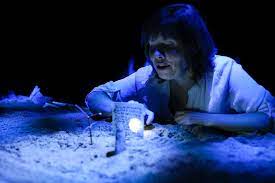Staged by Winnipeg, Manitoba’s Shakespeare in the Ruins
Teaching the world of Shakespeare’s plays to high school students for thirty some years certainly came in handy in watching a filmed recording on location at The Prairie Theatre Exchange Mainstage of Vern Thiessen’s ‘Shakespeare’s Will’.
But that wasn’t enough for me.
A basic introduction of William Shakespeare is made clear in playwright Thiessen’s script. Anne Hathaway (Debbie Patterson) is six years older than her husband. There are three children from this marriage: Susannah and twins Hamnet (called Harry in the script) and Judith. Will leaves his family to go work in the theatre while his wife remains at home with the children. There was reference in Shakespeare’s will that upon his death Anne would receive his second-best bed.
Beyond this rudimentary knowledge, I have no idea if playwright Thiessen completed any research into Anne’s life and how she coped in raising three children while her husband was away earning a living in the sinful theatre and sending money back home to his family.
I didn’t care about that at all.
Instead, I cared more about wondering if I was going to see a production that would grab my attention. I’ve always been intrigued with the Elizabethan era in which Shakespeare wrote plays and the myriad of individuals from that time and their connections. Since I had seen photos and brief commentary on Winnipeg’s Shakespeare in the Ruins Facebook page that this would be a solo performance featuring artist Debbie Patterson, I had some questions in whether a solo artist and script could possibly do justice to this complex and intriguing world of the Bard.
I needn’t have had to worry about that.
To quote Lucie Arnaz Luckinbill about the recent upcoming film version of her parents in Aaron Sorkin’s ‘Being the Ricardos’: “It’s frickin’ amazing.”
The same holds true here for Thiessen’s engaging script and this SIR consuming production filmed by Sam Vint.
The play opens where artist Debbie Patterson wheels herself out in front of what at first resembles a rectangular sandbox with various small objects of small twigs and what I thought looked like a small piece of birchbark. And that’s it. Hugh Conacher’s Lighting Design sharply focuses those moments of dramatic intensity where needed.
I’m sure Director Eric Blais worked closely with Patterson to ingrain a sometimes gritty, sometimes raw based naturalistic performance. If Anne sensed that her husband had a male lover in London, she too was also going to enjoy that same ‘pleasure’ as he may have done. I simply forgot that she is in a wheelchair and just focused on her splendid command of telling the story fearlessly and unashamedly especially in learning about honoring the vows Anne and Will (supposedly? possibly?) made to each other regarding living their own lives.
A definite fascination for me was watching Patterson ‘play’ with the sand in the sandbox. At the top of the show, we learn that Anne just buried her husband that morning in the Church and she is at home right now talking to him. Periodically she is reminded of events from her past when she was alone with the children and when she had to leave her home in the country and travel to the sea for the fear of the plague which crippled city life.
All the while she tells the story, Patterson’s hand movements in the sand are not just mere play. They are carefully choreographed as objects are sometimes pulled from the sand while others are placed at the side. Small twigs, tiny objects and carefully built wooden frames (that sometimes reminded me of Jenga) were placed around the box for certain effects.
But why the use of sand?
And then it dawned on me about halfway through why sand was used as an effective dramatic tool. A possible spoiler alert to follow (or this is what I saw).
As Anne, Patterson delivers a virtuoso solo performance in sharing a life that was not perfect, but whose life is perfect? Nevertheless, one hopes that all lives can be built on solid foundation (of trust, of love, of acceptance) within a marriage and raising a family. Here, in this production, nothing is concrete and can remain solid and standing within sand. It can be wiped away quickly, and Patterson was constantly moving the sand around to remind there is no solid foundation here within this family and these loves.
Clever, unique, different, and sad.
Running Time: approximately 90 minutes.
‘Shakespeare’s Will’ will be streamed online until December 5. Tickets are Pay What You Choose: $1, $5 $10. For more information and how to stream the production, visit www.shakespeareintheruins.com.
Artistic and Production Team:
Written by / Vern Thiessen
Directed by / Eric Blais
Costume Design / Debbie Paterson & Eric Blais
Props Design / Eric Blais & Heather Lee Brereton
Scenic Design / Adam Parboosingh
Scenic Design Assistant / Joyce Licup
Sound Design / Ridge Romanishen & Chris Coyne
Light Design / Hugh Conacher
Production Manager / Hugh Conacher
Stage Manager / Ridge Romanishen
Props & Wardrobe Coordinator / Heather Lee Brereton
Scenic Carpenter / Khaeler Bautista
Film Director / Sam Vint
Camera Operators / Tyler Funk, Rudy Gauer
Audio Mixer / Chris Coyne
Editor / Jonathan Lê
Audio Description provided by Vocal Image Ensemble Winnipeg.
Translation and subtitling provided by PARENTY REITMEIER, INC.
















